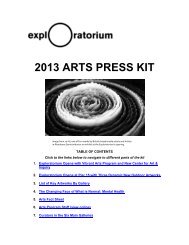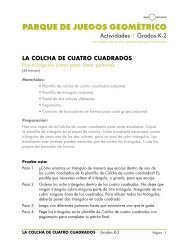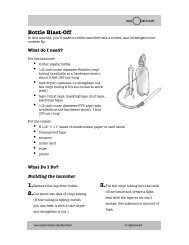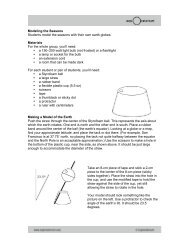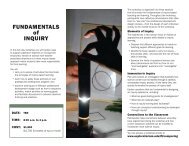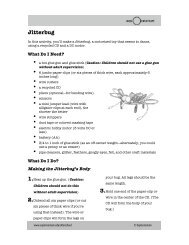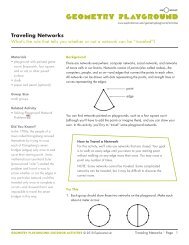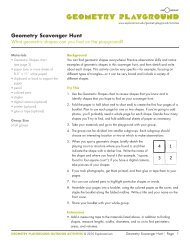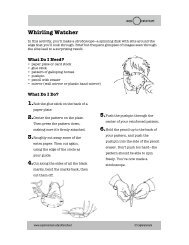Make Your Own Petroglyph! The sun dagger used ... - Exploratorium
Make Your Own Petroglyph! The sun dagger used ... - Exploratorium
Make Your Own Petroglyph! The sun dagger used ... - Exploratorium
You also want an ePaper? Increase the reach of your titles
YUMPU automatically turns print PDFs into web optimized ePapers that Google loves.
<strong>Make</strong> <strong>Your</strong> <strong>Own</strong> <strong>Petroglyph</strong>!<br />
<strong>The</strong> <strong>sun</strong> <strong>dagger</strong> <strong>used</strong> by Chacoans to mark the passing of seasons is what archeologists<br />
call a “petroglyph.” A petroglyph is a symbol that has been carved into a rock surface by<br />
pecking or scraping with another rock. People in many ancient cultures around the world<br />
created rock art, and there are many surviving petroglyphs to be found in the deserts of<br />
the American Southwest.<br />
While lots of rock art is quite beautiful, chances are it wasn’t created for aesthetic<br />
reasons. <strong>Petroglyph</strong>s were <strong>used</strong> to convey messages and ideas. <strong>The</strong>y aren’t read like<br />
words, or even like ancient hieroglyphics. <strong>The</strong>y’re symbols that can represent anything<br />
from a simple object to a complex idea. Our modern cultures also use symbols in similar<br />
ways.<br />
Interpreting rock art can be difficult. <strong>The</strong> symbols were created by a culture that is<br />
different than ours, and therefore an archeologist must know something about that<br />
culture in order to consider what the rock artist was trying to say. Some petroglyphs are<br />
fairly well understood, while others are the subject of great debate.<br />
Modern "<strong>Petroglyph</strong>s"<br />
In our modern cultures, we still use lots of symbols to represent ideas, some simple,<br />
some complex. Here are some common glyphs <strong>used</strong> in our modern world:<br />
What does each of these symbols stand for? What meanings do they have in your<br />
culture?<br />
Often we don't realize how complex ordinary ideas in our culture are. <strong>The</strong>re’s more<br />
behind the meaning of a picture than just the object, event, or person it represents.<br />
Imagine that you had to explain the meaning of each of these symbols to an ancient<br />
Chacoan. What would you have to tell them about your culture in order to make them<br />
understand what the symbols mean?
Same Object, Different Symbol<br />
<strong>The</strong>re are some human experiences—birth, death, sky, earth—that are so universal,<br />
nearly every culture has symbols for them. But the symbols differ from culture to culture.<br />
For example, here are a variety of <strong>sun</strong> symbols from various parts of the world:<br />
Common <strong>sun</strong> symbol<br />
found in many cultures<br />
China Peru, probably Incan Mohenjo-Daro region<br />
(now Pakistan)<br />
Euphrates-Tigris<br />
region (now Iraq)<br />
How are they alike? How are they different? What can the similarities and differences in<br />
the symbols tell us about the similarities and differences in how the cultures experienced<br />
the <strong>sun</strong>?<br />
<strong>Petroglyph</strong>s at Chaco Canyon<br />
Glyphs, symbols, and pictures had a purpose for the Chacoan people, as they do for<br />
most other cultures. While they may be beautiful, the intent behind them was to<br />
communicate a message.<br />
Here are some petroglyphs (#1 is actually a pictograph, which means it’s painted onto,<br />
rather than carved into, the rock) found in the Chaco Canyon area. What do you think<br />
they might mean?<br />
#1 #2 #3 #4<br />
You can find out more about some of these images by looking at pages and movies on<br />
our Web site:<br />
• <strong>The</strong> Time section contains images 1, 3, and 4:<br />
http://www.exploratorium.edu/chaco/HTML/time3.html
• <strong>Petroglyph</strong> 3 appears on the boulder Piedra del Sol:<br />
http://www.exploratorium.edu/chaco/HTML/piedra.html<br />
• <strong>Petroglyph</strong> 2 points the way to a sacred site at Wijiji:<br />
http://www.exploratorium.edu/chaco/HTML/wijiji.html<br />
• All of these images are related to the <strong>sun</strong>, the sky, or places to observe them. In<br />
our Sun Stories movie, researchers and tribe members describe the importance<br />
of the <strong>sun</strong> to Native American cultures.<br />
Sun Stories movie: http://www.exploratorium.edu/chaco/HTML/<strong>sun</strong>stories.html<br />
<strong>Make</strong> <strong>Your</strong> <strong>Own</strong> <strong>Petroglyph</strong><br />
As you can see, the seasons were very important to Chacoan people. <strong>The</strong> seasons are<br />
still an essential part of life in our modern cultures, though sometimes for different<br />
reasons.<br />
Think about how the seasons are important to you. In what ways do the seasons affect<br />
your life? Draw a "petroglyph" that you think represents something significant about the<br />
seasons to you. You can incorporate modern symbols, or devise a completely original<br />
"petroglyph."<br />
Show your "petroglyph" to other people and ask what their interpretation of it would be.<br />
In a classroom, you could work in pairs or small groups and take turns interpreting each<br />
others' symbols.<br />
How easy or hard is it to determine the meaning of symbols created by other students?<br />
What strategies could you use to make it easier?<br />
If your "petroglyph" were on a wall, how would it be different than graffiti?
Teacher Tips<br />
Grade Level<br />
3–9<br />
National Standards Addressed<br />
Grades 9–12:<br />
History & Nature of Science: Historical Perspectives<br />
Grades 5–8:<br />
History & Nature of Science: History of Science<br />
Grades: K–4:<br />
History & Nature of Science: Science as a Human Endeavor<br />
Abilities of Technological Design: Understandings about Science & Technology<br />
Key Concepts<br />
Rocks, symbols, ancient cultures, universal themes of nature, symbols as<br />
communication, archeoastronomy, solar markers<br />
Background Science<br />
From the National Park Service Site for <strong>Petroglyph</strong> National Monument<br />
What are petroglyphs?<br />
http://www.nps.gov/petr/Cultural%20Resources/What.htm<br />
Why were petroglyphs made?<br />
http://www.nps.gov/petr/Cultural%20Resources/Whymade.htm<br />
From the Arkansas Archeological Society<br />
What’s the difference between rock art and graffiti?<br />
http://rockart.uark.edu/qfgraffiti.html<br />
Ideas for Discussion<br />
• What symbols in use today represent universal concepts (water waves, stick<br />
figure people, fish, <strong>sun</strong>)? Can you imagine that rock art depicting these concepts<br />
might use similar symbols?<br />
• <strong>The</strong>re is more rock art in the American Southwest than in other parts of the<br />
United States. Why would this be? (Hint: It’s not related to the number of people<br />
who lived there or whether people made rock art in other places.)<br />
• Archeologists often disagree on the interpretation of rock art symbols. What<br />
things could they do to resolve debates? How could we know for certain what a<br />
rock art symbol means?<br />
• What role can present Native American cultures play in interpreting rock art?
Related Media<br />
• Our Time section has more information about Chaco petroglyphs:<br />
http://www.exploratorium.edu/chaco/HTML/time3.html<br />
Going Further<br />
• Imagine that you have to design a petroglyph like the <strong>sun</strong> <strong>dagger</strong> (see link<br />
below), where you’d like the <strong>sun</strong> to fall across it in certain ways on certain days of<br />
the year. What would you need to know to put the petroglyph in just the right<br />
place? How do you think the ancient Chacoan people figured out where to place<br />
their <strong>sun</strong> <strong>dagger</strong>?<br />
About the <strong>sun</strong> <strong>dagger</strong> petroglyph:<br />
http://www.exploratorium.edu/chaco/HTML/fajada.html<br />
• Learn more about how the seasons work with our activity, Modeling the Seasons:<br />
http://www.exploratorium.edu/chaco/HTML/TG-seasons.html
Some symbols commonly <strong>used</strong> by modern cultures
Common <strong>sun</strong><br />
symbol found<br />
in many<br />
cultures<br />
China<br />
Peru, probably<br />
Inca<br />
Mohenjo-Daro<br />
region (now<br />
Pakistan)<br />
Euphrates-Tigris<br />
region (now Iraq)<br />
A variety of ancient <strong>sun</strong> symbols




